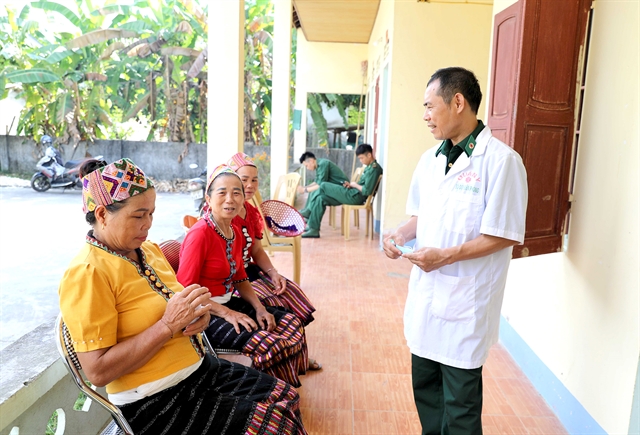 |
| Major and military doctor Nguyễn Bá Lương (right) talks to people coming to the ‘Border medicine cabinet’ in Phúc Sơn Commune for a health check. — VNA/VNS Photo Xuân Tiến |
NGHỆ AN — The ‘Border medicine cabinet’ model operated by the Phúc Sơn Border Guard Station in the past five years has promoted effectiveness of health care and treatments in four border villages.
It is one of eight border medicine cabinets set up by the Nghệ An Province Border Guard. In addition to maintaining security and order, the Guard Station has coordinated with local authorities to effectively implement economic and social development programmes.
It creates livelihoods and helps local people eradicate diseases and hunger, thereby gaining the trust and love of local officials and people.
Health care
Major and military doctor Nguyễn Bá Lương, 51, is in charge of the Phúc Sơn Border Guard Station’s medical cabinet.
Rain or shine, he diligently examines patients.
Vi Thị Thiết, 58, a Thái ethnic woman in Cao Vều 2 Village, Phúc Sơn Commune, Anh Sơn District, said that she regularly came to the ‘Border Medicine Cabinet’ to have her blood pressure measured, heart rate and joints checked and to receive free medicine.
Previously, when the medicine cabinet was not there, every time she was sick, she had to ask relatives to take her by motorbike to the commune health station, which is more than 20km along the forest road, along the hills and mountains. It was a really hard journey.
Many other patients said that since the ‘Border Medicine Cabinet’ was established, medical examination and treatment has become much more convenient.
Military doctors from the Phúc Sơn Border Guard Station are regularly present to promptly provide health care to people with a very enthusiastic attitude and thoughtful advice.
Regardless of night or day, every time people need to be examined, the military doctors are present, or they will cross mountains and forests to local people’s houses to check their health.
The Cao Vều 1, 2, 3, 4 villages in Phúc Sơn Commune are located upstream of Giang and Vều rivers, in the buffer zone of the Pù Mát primeval forest.
More than 40 years ago, the area was full of mountains and forests, with only a few dozen Thái ethnic households settling.
Currently, the four villages have nearly 400 households, with more than 1,340 people, of which Thái people account for more than 84 per cent.
In 2002, the Anh Sơn District People’s Committee built the Cao Vều Medical Substation. It arranges three medical workers to give first aid to the people.
In 2014, the medical substation moved near the Highway No 7.
Since then, every time people get sick, they have to travel more than 20km to the commune health station.
Senior Lieutenant Colonel Hoàng Thanh Tùng, Politician of the Phúc Sơn Border Guard Station, said that he understood the people’s difficulties in taking care of their health, especially for the elderly and children.
The unit had proposed the Nghệ An Border Guard Command set up a medicine cabinet and it was approved.
From February 2019, the ‘Border Medicine Cabinet’ model was established, located in Cao Vều 2 Village with one military doctor to supply free health care and medicine to the people.
The operating budget for the cabinet mainly comes from support of the provincial Border Guard Command, the Phúc Sơn Border Guard Station, the Red Cross Society, the Anh Sơn District Women’s Union and other agencies and benefactors.
Major Lương, who managed the cabinet, said that in the past five years, the unit had examined, treated and given free medicine to about 5,000 people.
Sometimes the soldiers have to go through the forest to examine and treat people at home, with the furthest house more than 6km from the unit.
People come mainly for high blood pressure problems, cardiovascular issues and bone and joint diseases. Children have acute respiratory and intestinal infections.
Work accidents in production also happen a lot and are promptly treated by military doctors.
For emergency cases, the unit will advise the patient for timely referral to an upper tier hospital.
Poverty reduction
Lieutenant Colonel Tùng said that the station managed and protected more than 26km of border, with seven landmarks, (numbers 441 to 447). The area is adjacent to Xaychamphone District, Bolikhamsai Province of Laos.
With a rugged mountainous terrain, many streams, frequent floods, landslides and traffic disruption in the rainy season, it is a difficult terrain to guard, but the unit has worked professionally to protect border sovereignty and security.
At the same time, it maintains good external affairs to build a united border area, growing friendship, with special solidarity and comprehensive cooperation between Việt Nam and Laos and Nghệ An and Bolikhamsai Province.
To effectively conduct socio-economic development programmes in the locality, the unit coordinates with the district Fatherland Front and Farmers’ Association to carry out a number of models such as helping impoverished students, raising pigs and chickens and growing plants.
Many households supported by the guard station have escaped poverty.
Ngân Thị Loan, who lives in Cao Vều 4 Village, is a case in point. She was supported with two breeding pigs, 100 chickens and technical help and has now accumulated capital to expand a livestock farm, grows one hectare of tea and 1.000sq.m of cassava. — VNS
- Reduce Hair Loss with PURA D’OR Gold Label Shampoo
- Castor Oil Has Made a “Huge” Difference With Hair and Brow Growth
- Excessive hair loss in men: Signs of illness that cannot be subjective
- Dịch Vụ SEO Website ở Los Angeles, CA: đưa trang web doanh nghiệp bạn lên top Google
- Nails Salon Sierra Madre
 VnExpress News The News Gateway of Vietnam
VnExpress News The News Gateway of Vietnam





